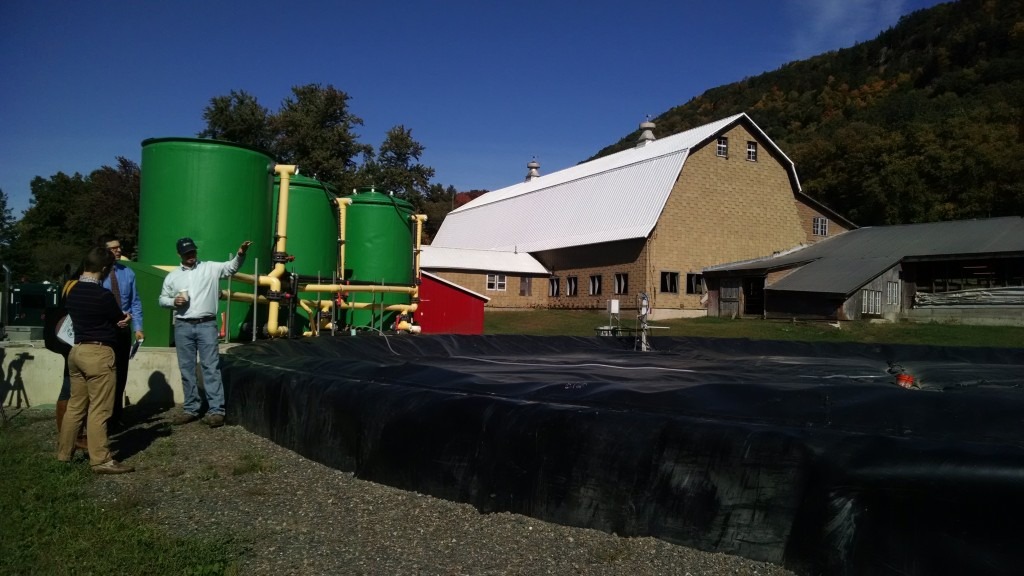By Hannah Nguyen Globe Correspondent, Updated February 19, 2023
The Boston Globe
A digester at Barstow’s Longview Farm in Hadley takes methane from cow manure and food waste and turns it into enough electricity to power 1,600 homes.
Barstow’s Longview Farm in Hadley is working to help businesses by taking their food waste and turning it into clean energy through the farm’s anaerobic digester.
Massachusetts throws away a million tons of trash every year. And since November, businesses that generate more than half a ton of food waste a week can no longer dispose of it in landfills or incinerators.
Barstow’s Longview Farm in Hadley is working to do something about that by helping businesses turn food waste into clean energy through an anaerobic digester. The digester, which it built in 2013 and is run by Vanguard Renewables, takes methane from cow manure and food waste and turns it into enough electricity to power 1,600 homes.
The tank operates like a cow’s stomach, said Denise Barstow Manz, a seventh-generation dairy farmer and head of education at Barstow’s Longview Farm. Food waste and manure are mixed together, and the microbes from the manure break down the food. Methane gas then rises to the top of that tank and goes through what the farm calls “biological scrubbers” that remove sulfur particles. The methane burns in an engine, and that energy turns a generator that makes electricity, which goes out to the power grid.
The digester operates on a daily basis. The process produces more than 5,100 megawatt hours of electricity and 30,000 tons of fertilizer annually. The system also sequesters 85 percent of the greenhouse gases produced on the farm.
Each year, about 9,000 tons of manure and 14,000 tons of food are processed through the farm’s 600,000-gallon anaerobic digestion tank.
The food waste comes from food manufacturers, processors, and companies such as Cabot Creamery/Agri-Mark Co-operative, Geissler’s Supermarkets, HP Hood, Wind River, Cains, Garelick, Amenico, and McDonald’s.
Barstow’s Longview Farm sends its milk to Cabot Creamery/Agri-Mark Co-operative butter plant in West Springfield to be processed into butter. Cabot Creamery then sends any wastewater to the digester. In turn, the farm’s anaerobic digester provides renewable energy through Eversource grid to the creamery as well as the surrounding community.
“We’ve got this kind of closed-loop system going with them,” Barstow Manz said. “That digestate is going to go onto the land, create food for animals, and [provide] more high-quality milk.”
About 9,000 tons of manure a year is processed through Barstow’s Longview Farm’s 600,000-gallon anaerobic digestion tank.
In the early 2000s, when the milk market was crashing, the farm was getting $12 per 100 pounds of milk when the break even was about $22 per hundredweight. Barstow Manz said it was a difficult time for the family-owned operation, which had to find new ways to generate income.
“We sat down and talked [and said] we need to diversify our farm or get out of agriculture,” Barstow Manz said. “We didn’t want to do that.”
It contacted other dairy farmers who were interested in an anaerobic digester. “Because there were [all] of us all together, we had a louder voice, and legislators were interested in what we were doing,” Barstow Manz. “We [also] got investors interested.”
Jordan Dairy Farms in Rutland was the first in the state to produce energy from an anaerobic digester in 2009. Barstow’s Longview Farm was the second farm to build one.
Since it built its digester, the farm has enjoyed increased soil health, crop yields, and food per acre for its animals, while also decreasing the farm’s chemical fertilizer use by about 90 percent, Barstow Manz said.
